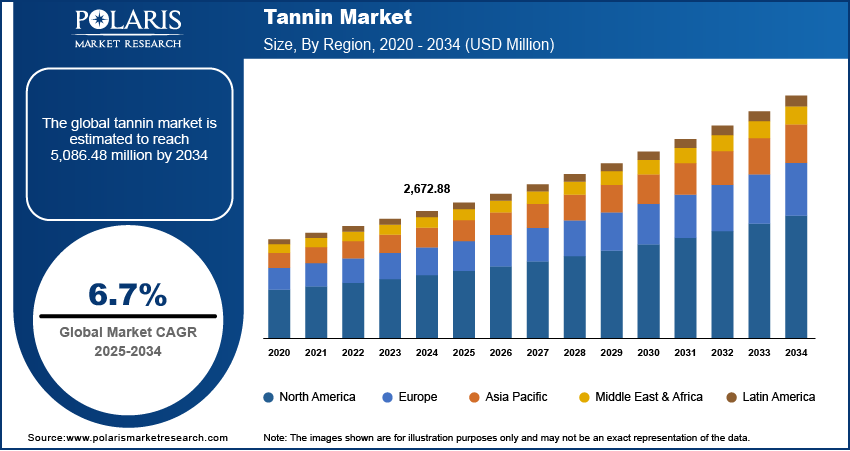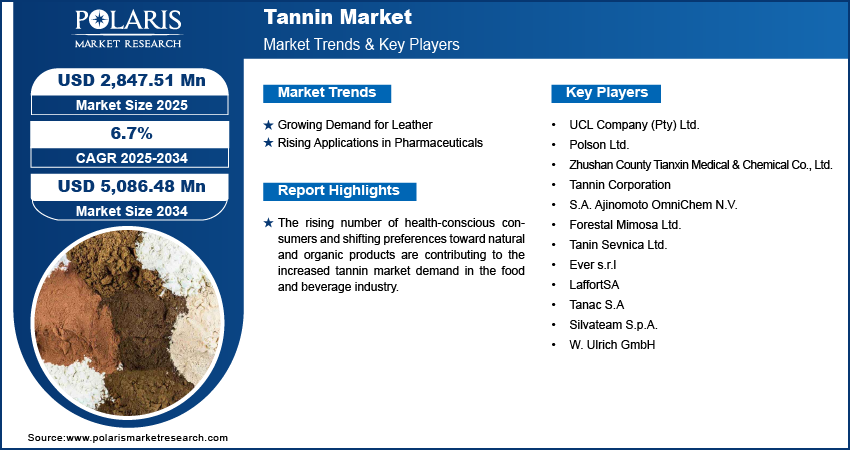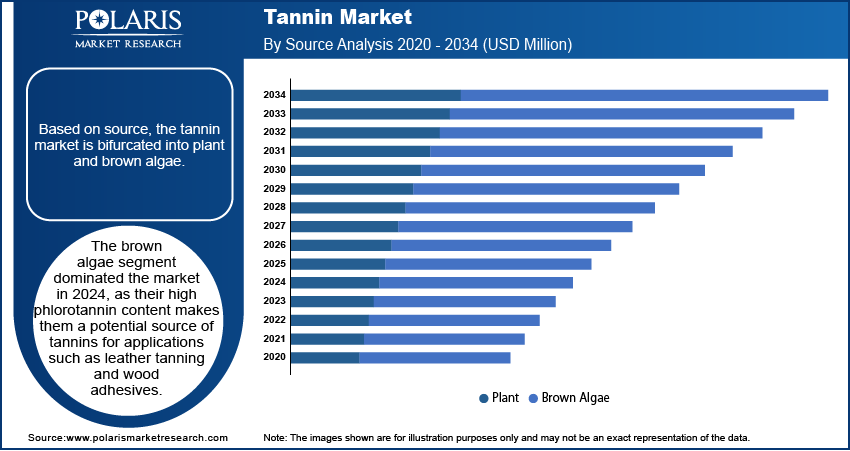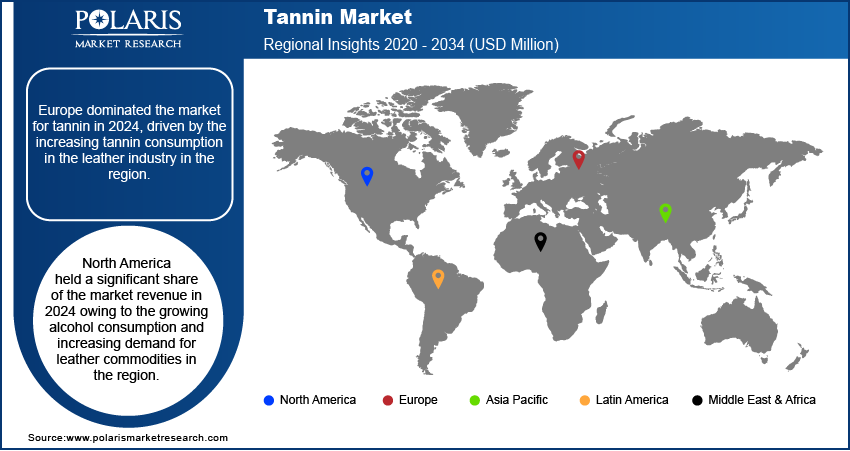
Tannin Market Size, Share, Trends, Industry Analysis Report: By Source (Plant and Brown Algae), Product Type, Application, and Region (North America, Europe, Asia Pacific, Latin America, and Middle East & Africa) – Market Forecast, 2025–2034
- Published Date:Jan-2025
- Pages: 118
- Format: PDF
- Report ID: PM1046
- Base Year: 2024
- Historical Data: 2020-2023
Tannin Market Overview
The global tannin market size was valued at USD 2,672.88 million in 2024. The market is projected to grow from USD 2,847.51 million in 2025 to USD 5,086.48 million by 2034. It is projected to exhibit a CAGR of 6.7% from 2025 to 2034.
Tannins are biomolecules with astringent properties that are extracted from various parts of plants and fruits, including seeds, bark, stem tissues, leaves, and roots. These compounds help protect plants from predation and assist in regulating their growth. Fruits rich in tannin include blueberries, cranberries, hazelnuts, strawberries, walnuts, pecans, oranges, and grapes.

To Understand More About this Research: Request a Free Sample Report
Tannins are commonly used as natural food additives and flavor enhancers in the food & beverage industry. The rising number of health-conscious consumers and shifting preferences toward natural and organic products are contributing to the increased tannin market demand in the food and beverage industry. Also, the high usage of tannin in cosmetics and personal care products due to its anti-inflammatory, antioxidant, and astringent properties is driving the development of the market.
Tannin plays an important role in wine by contributing to the mouthfeel, structure, and aging potential of the beverage. The rapid growth of the wine industry, fueled by higher disposable income and consumer’s willingness to pay a premium for high-end products such as wine, is propelling the tannin market expansion. With the increasing focus on developing new and innovative applications of tannins, there is a growing demand for research and development activities in this field. This trend is expected to drive the market growth in the coming years.
Tannin Market Dynamics
Leather is often produced using tannin extracted from various tree parts, including the bark, roots, and leaves. This substance is used in the tanning process of leather as its insoluble proteins prevent decomposition. Also, it enhances the leather's durability, strength, and water resistance. The use of leather in household items, automotive applications, and shoes and garments is becoming increasingly popular. As a result, the demand for tannin extracts used in leather tanning has surged, driving the tannin market revenue.
Rising Applications in Pharmaceuticals
Tannins are known for their antimicrobial, antiviral, and anticancer properties. Tannin-based pharmaceuticals are used to treat intestinal infections as they react with proteins in bacterial membranes, neutralizing their activities. Tannins can also help with wound healing, diarrhea, and protecting the cardiovascular system. The rising prevalence of chronic conditions and the need for new and effective treatments are driving the demand for compounds such as tannins, impacting the tannin market development favorably.

Tannin Market Segment Insights
Tannin Market Outlook by Source Insights
The tannin market, based on source, is bifurcated into plant and brown algae. The brown algae segment dominated the market with a revenue share of 78.4% in 2024. Brown algae are located in various aquatic environments, such as rock pools, tidal splash zones, intertidal zones, and nearshore waters. These algae are typically fast-growing and large seaweeds. Their high phlorotannin content makes them a potential source of tannins for applications such as leather tanning and wood adhesives, contributing to the segment’s dominance in the market.
Tannin Market Assessment by Application Insights
The tannin market, based on application, is segmented into wine production, tea, coffee, juices, medical/pharmaceutical, leather tanning, wood adhesives, and others. The wood adhesives segment is projected to register the highest CAGR of 6.1% from 2025 to 2034. The rising manufacturing of wood products has led to increased demand for wood adhesives. Tannins are used in wood adhesives owing to their natural binding properties and ability to form strong bonds. Also, tannin-based adhesives are more sustainable than synthetic adhesives and are known to have water-resistant properties.

Tannin Market Regional Analysis
By region, the market report offers tannin market insights into North America, Europe, Asia Pacific, Latin America, and the Middle East & Africa. Europe dominated the market with a 40.4% revenue share in 2024, driven by the increasing tannin consumption in the leather industry in the region. Germany, being the third largest leather producer in Europe and home to 100 leather manufacturers, utilizes a significant amount of tannin. The high usage of tannin in the wine industry further contributes to the regional market dominance.
North America, following Europe, held a significant share of the tannin market revenue in 2024. Growing alcohol consumption and increasing demand for leather commodities are among the key market drivers in the region. In addition, the presence of several major players contributes to the market development in the region.

Tannin Market – Key Players and Competitive Insights
The tannin market is characterized by fragmentation. It has the presence of several small and medium-sized companies. The leading market players are making significant investments in R&D to extend their offerings. Also, they are undertaking several strategic initiatives such as mergers and acquisitions and partnerships to improve their global reach. To expand and survive in a more competitive environment, market participants must offer innovative solutions.
In recent years, the tannin market has witnessed several technological and innovation breakthroughs, with key players seeking to provide advanced solutions that help meet sustainability goals. The tannin market research report offers a market assessment of all the key players, including UCL Company (Pty) Ltd.; Polson Ltd.; Zhushan County Tianxin Medical & Chemical Co., Ltd.; Tannin Corporation; S.A. Ajinomoto OmniChem N.V.; Forestal Mimosa Ltd.; Tanin Sevnica Ltd..; Ever s.r.l; LaffortSA; Tanac S.A; Silvateam S.p.A., and W. Ulrich GmbH.
List of Key Players in Tannin Market
- UCL Company (Pty) Ltd.
- Polson Ltd.
- Zhushan County Tianxin Medical & Chemical Co., Ltd.
- Tannin Corporation
- S.A. Ajinomoto OmniChem N.V.
- Forestal Mimosa Ltd.
- Tanin Sevnica Ltd..
- Ever s.r.l
- LaffortSA
- Tanac S.A
- Silvateam S.p.A.
- W. Ulrich GmbH
Tannin Industry Developments
February 2024: Silvateam S.p.A. announced the acquisition of wet-Green GmbH from MB-Holding GmbH. With the acquisition, Silvateam aims to establish itself as a leader in sustainable innovations in the leather industry.
August 2020: Tannin Corporation announced the addition of new fatliquors and dispersing agents to its portfolio. The company stated that the addition of the new products will significantly improve its product portfolio.
Tannin Market Segmentation
By Source Outlook
- Plant
- Brown Algae
By Product Type Outlook
- Hydrolysable
- Pyrogallol-Type Tannin
- Non-Hydrolyzable
- Condensed
- Phlorotannin
By Application Outlook
- Wine Production
- Tea
- Coffee
- Juices
- Medical/Pharmaceutical
- Leather Tanning
- Wood Adhesives
- Others
By Regional Outlook
- North America
- US
- Canada
- Europe
- Germany
- France
- UK
- Italy
- Spain
- Netherlands
- Russia
- Rest of Europe
- Asia Pacific
- China
- Japan
- India
- Malaysia
- South Korea
- Indonesia
- Australia
- Rest of Asia Pacific
- Middle East & Africa
- Saudi Arabia
- UAE
- Israel
- South Africa
- Rest of Middle East & Africa
- Latin America
- Mexico
- Brazil
- Argentina
- Rest of Latin America
Tannin Market Report Scope
|
Report Attributes |
Details |
|
Market Size Value in 2024 |
USD 2,672.88 million |
|
Market Size Value in 2025 |
USD 2,847.51 million |
|
Revenue Forecast by 2034 |
USD 5,086.48 million |
|
CAGR |
6.7% from 2025 to 2034 |
|
Base Year |
2024 |
|
Historical Data |
2020–2023 |
|
Forecast Period |
2025–2034 |
|
Quantitative Units |
Revenue in USD million and CAGR from 2025 to 2034 |
|
Report Coverage |
Revenue Forecast, Market Competitive Landscape, Growth Factors, and Trends |
|
Segments Covered |
|
|
Regional Scope |
|
|
Competitive Landscape |
|
|
Report Format |
|
|
Customization |
Report customization as per your requirements with respect to countries, regions, and segmentation. |
FAQ's
The market was valued at USD 2,672.88 million in 2024 and is projected to grow to USD 5,086.48 million by 2034.
The market is projected to register a CAGR of 6.7% from 2025 to 2034.
Europe accounted for the largest region-wise market size in 2024.
A few of the key players in the market are UCL Company (Pty) Ltd.; Polson Ltd.; Zhushan County Tianxin Medical & Chemical Co., Ltd.; Tannin Corporation; S.A. Ajinomoto OmniChem N.V.; Forestal Mimosa Ltd.; Tanin Sevnica Ltd..; Ever s.r.l; LaffortSA; Tanac S.A; Silvateam S.p.A., and W. Ulrich GmbH.
The brown algae segment accounted for a larger market share in 2024
The wood adhesives segment is anticipated to register the highest CAGR during the forecast period.
